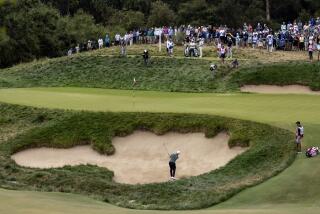Course Keeps Stiff Upper Chip
- Share via
GULLANE, Scotland — Muirfield, designed by Old Tom Morris, has been the site of the 1892 British Open and 13 others since, which makes it one of the most famous golf courses in the world.
It is also one of the stuffiest.
In fact, over the years, Muirfield has built such a solid reputation for snobbery that monocles are sold in the pro shop, silk kerchiefs are flown on the flagsticks and they use butlers instead of caddies. All right, those are wild exaggerations, but the truth is, Muirfield is to golf clubs what starch is to dress shirts.
To maintain the kind of atmosphere Muirfield desires, there is no pro shop, because there is no pro. No souvenirs, either. Only balls, tees and a guide to the course are available, so if you’re looking for that special Muirfield logo cashmere sweater, it just isn’t available.
There are no female members at Muirfield, and no junior program either.
In the exclusionary department, Muirfield isn’t much different from Royal St. George’s and Royal Troon, the next two British Open sites that also are male-only clubs. The Royal and Ancient Golf Club of St. Andrews, which runs the Open Championship, is a male-only club, as well, but R&A; Secretary Peter Dawson sees no problem there.
“I honestly don’t think social engineering is part of our role,” he said. “We’re here to hold the Open Championship and will do it on the best links possible.”
So there.
That policy is only a small part of the story of this club, located not far from Edinburgh and the Firth of Forth.
It’s an old story, but Muirfield is an old place, rich in tradition and history, exhibiting all the snootiness and downright quirkiness that you might expect from the jewel of the Honourable Company of Edinburgh Golfers, the links at Muirfield.
First of all, the Honourable Company of Edinburgh Golfers--the members at Muirfield wear badges bearing the initials “HCEG”--is actually the oldest golf club in the world, or so the HCEG says. There is no doubt that the HCEG produced golf’s first set of rules, or that it is 10 years older than the Society of St. Andrews Golfers, even though the Royal and Ancient gets most of the historical attention, plaudits, clout and recognition.
The two golf groups still feud. In 1992, the last time it staged an Open Championship, Muirfield wouldn’t allow the R&A; to build bleachers at the 18th green because the structure might have obstructed the view of the members in the clubhouse.
The British Open began in 1860 and the event came to Muirfield for the first time 32 years later, a year after Morris had designed the “new” course. According to legend, the new course at Muirfield wasn’t that well received 110 years ago.
Andrew Kirkaldy of St. Andrews is supposed to have snipped, “It’s naught but an auld water meddie. I’m glad I’m going home.”
In 1922, Harry Colt redesigned the course, using a new 50-acre track north of the course, expanding it while still keeping Morris’ routing plan.
The first nine holes circle clockwise, the back nine counterclockwise, but in a circle inside the circle made by the first nine holes. If that sounds confusing, it isn’t, as long as you have a clock.
What’s confusing is the wind, which usually blows from the west, and can cause problems because there are never more than three holes going in any one direction.
In his book “Open Championship Golf Courses of Britain,” Keith Mackie described Muirfield’s reputation:
“More than any other golf club, Muirfield keeps the world at bay; its feet are firmly planted in the past and there are guardians at the gates to keep uninvited guests and, so far as possible, the 20th century in general, at bay.”
Proof? Go back to 1980 at Muirfield, where Tom Watson had won his third British Open title and later that night decided to get back on the links with Ben Crenshaw, who had finished third.
Crenshaw and Watson had played the 10th and 18th holes when a man saw what was happening and ran up to them, waving a flashlight.
“This is no playground!” said Captain P.W.T. “Paddy” Hanmer, Royal Navy (Ret.), and most important, secretary of the Honorauble Company of Edinburgh Golfers. “I’ll see to it that you are banished from this course forever!”
The miscreants were scolded like children, then shooed away.
Hanmer’s reign lasted from 1968-83 and he ruled with an iron fist. Jack Nicklaus once asked to play and Hanmer turned him down cold. The same thing happened to Payne Stewart. Part of Paddy’s job also called for him to eject visiting players who were playing too slow.
But then, Hanmer sprang from a long line of professional party-poopers, a group that also included Col. Brian Evans-Lombe, a retired cavalry officer who was appointed secretary in 1947. According to Muirfield lore, Evans-Lombe noticed someone he didn’t know in the smoking room. The secretary asked the man’s identity. The man told him his name, saying that he had been a club member for 20 years.
“In that event,” Evans-Lombe said, “you should come more often. Then I would recognize you.”
Before the first round of the 1948 Open at Muirfield, Masters champion Claude Harmon’s playing partner suddenly withdrew. A substitute was located in the clubhouse, retired Maj. W. H. Callender, who remarked, “I’d be delighted to give the old fellow a game.”
When reporters learned that something unusual was happening, they found Callender on the third fairway, giving Harmon advice on his swing--”Gripped down the shave, a short swing controls the ball more easily in the east wind.”
Some of the greatest players in the game have won at Muirfield. Nicklaus thought so much of the place, he named his home course in Ohio after it--Muirfield Village. Nicklaus, who saw the course for the first time in 1959, when he was a 19-year-old amateur playing in the Walker Cup matches, won the 1966 British Open at Muirfield.
But Nicklaus isn’t the only great to have stood transfixed on the hallowed ground and have his name linked for all time with venerable Muirfield. Harry Vardon won here. So did Ted Ray, Walter Hagen, Gary Player, Watson and Lee Trevino. Along the way, Muirfield never grew into anything other than what it is, what it was, what it always has been--a strange and wonderful place where strange and wonderful things happen.
The famous British golf writer Bernard Darwin, whose “Golf Courses of the British Isles” was published in 1910, found Muirfield “thoroughly difficult,” although quite wonderful.
“There is a fine view of the sea and a delightful sea wood, with the trees all bent and twisted by the wind; then, too, it is a solitary and peaceful spot, and a great haunt of the curlews, whom one may see hovering over a championship crowd and crying eerily amid a religious silence.”
A curlew is a long-beaked, small-headed shorebird, so keep your eyes open for them. You might want to stay alert for just about anything at Muirfield, though.
Muirfield might be the most politically incorrect of major championship courses. Women can’t be members and are not allowed in the clubhouse. Women aren’t really welcome to even enter the front gate, although since 1904, they have been permitted to play the course. There are no women’s tees, though.
When the club’s kitchens underwent remodeling several years ago, members took their meals at the nearby Greywalls hotel. Without being prompted, Greywalls followed club rules and refused to seat women for lunch.
More to Read
Sign up for The Wild
We’ll help you find the best places to hike, bike and run, as well as the perfect silent spots for meditation and yoga.
You may occasionally receive promotional content from the Los Angeles Times.






